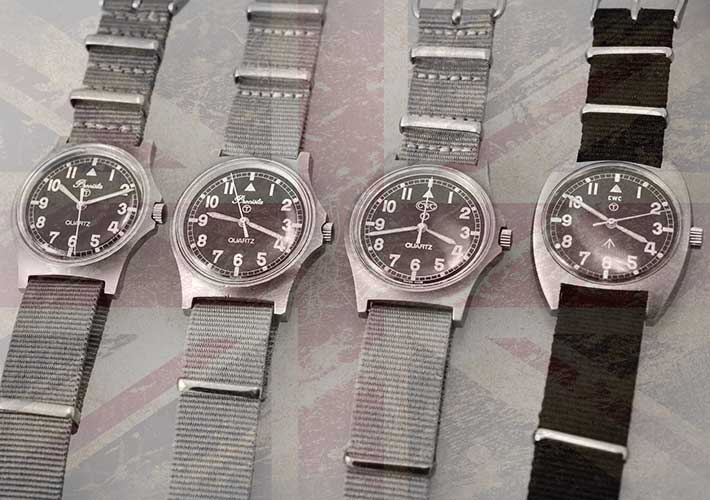
W-10 the queen, The British military watch of the late seventies.
At the end of the 1970s, the stock of Commonwealth military watches had far exceeded its potential use. Coming mostly from watches that began their career in the early fifties, see during the Second World War, the "Dirty Dozen" ordered by Winston Churchill during the Second World War display a more than remarkable operational service time, but which begins to pose serious maintenance problems. The constraints to which these watches are subjected daily have also evolved. The technology and the missions of the British forces involve new uses and above all new constraints that apply to the equipment used. The sixties redistribute the cards of the strategic game board on which the NATO forces are engaged: It is the time of the cold war, an era of operational watch which begins in 1946 and which will end in 1991.

A period that will designate Great Britain as the sentinel of the northwest flank of the Iron Curtain, with the mission of monitoring the North Sea, the area between Scotland and Iceland. During these years, the British forces will provide naval and air surveillance of the western area of evolution of the Warsaw Pact forces. An area through which long-range Soviet Tupolev 95 “Bear” submarines, ships and aircraft pass regularly to join their patrol and reconnaissance area in the North Atlantic.
It was at the beginning of the 1970s that the Ministry of Defense changed the staffing standard with the arrival of a new watch: The reference W-10, a manually wound mechanical watch initially manufactured by Hamilton then by CWC and whose specifications are the use of an ETA caliber 2750 movement, 17 jewels operating at 21,600 vibrations per hour. A watch with a matte black dial with Tritium indexes indicated by a circled "T", a dotted hour rail decorated with numerals, a triangle at twelve o'clock and the display of the Broad-Arrow in the bottom of the dial. Watch with 36 mm case in non-magnetic steel with bracelet fixing pumps welded to the case. Series references and markings engraved on the back of the case.

Quickly Hamilton, entangled in the financial difficulties which will affect the entire watchmaking sector of the seventies, will throw in the towel and stop producing watches for the public markets to refocus on the civilian markets, leaving in 1976 CWC to produce these watches for the British Ministry of Defence.
In 1980, the use of Quartz, widely acclaimed by the watchmaking sector, will change the demand of the military: the Model W-10 will receive new specifications on a quartz movement base, while keeping its external appearance, quartz movements more compact will nevertheless change the volume of the case and reduce over time the size and thickness of the case.

The new "Queen Watch W-10" will be produced by CWC and Precista and there are three case sizes to be identified, a "Fat Boy" or even called "Jumbo" model with a thickness of 13 mm produced in 1982 by Precista with an AS 536 quartz movement, then a semi “Jumbo” model 11.3 high produced by CWC from 1984 and using a Ronda 715 quartz movement or an ETA-ESA 947.111, then after around 1986 a production stabilized around a case "thin case" of 38.6 X 42 mm and 10.2 mm in height produced jointly by Precista (the brand used by Southerns Watches & Clocks Supplies Limited for its military productions) and CWC (Cabot Watches Company) These watches will be produced until in the late nineties until the cessation of activity of CWC before the 2000s (The brand will be taken over in the early 2010s and will resume a "testimonial" production resembling the original vintage productions.
On the strength of this restart, the company will produce several models that will raise its notoriety until it remobilizes the attention of the military and raises interest in its production. The production of small special series will follow, exclusively sold to military personnel or governmental organizations.
In this line, we can identify the g-10 Pegasus Airborne model, a military watch sold to members of the unit and produced in less than a hundred copies in 2020, to celebrate the eighty years of the creation of the regiment during the second World War. This rare watch bears on the dial the mentions and logo of the English paratrooper units (airborne) and the famous Pegasus, the unit's mascot. on the back are repeated these elements along with the order number of the watch in the series. The 38mm 5 ATM waterproof case houses the ETA 955.102 caliber, and a brown NATO strap accompanies the fixed-pump watch, in full compliance with the specifications of English military watches.

Another model of g-10 in a very limited series, the G-10 model of the Progetimus CPU unit (Close Protection Unit... the British Secret Service which protects personalities, such as the GSPR or the GIGN in France) A watch also reserved to members of the unit or to those who have completed and passed the Longmoor or Hereford course.
These watches used by all the "land, air, sea" forces of the Commonwealth are also considered to be the last series military equipment watches having been engaged in an open conflict: Falklands War for the W-10 of the Royal Navy and the Royal Air Force. W-10 SAS units and the Navy and Royal Air Force during the Gulf War, these compact watches are increasingly appreciated by collectors and in a wider scope by many vintage watch enthusiasts. Model worn by many military women; these watches have arrived on the wrists of very prominent fashionistas who have exploded the rating of these watches. A booster effect by the new post-Brexit customs barriers which will further increase the value of these watches.


